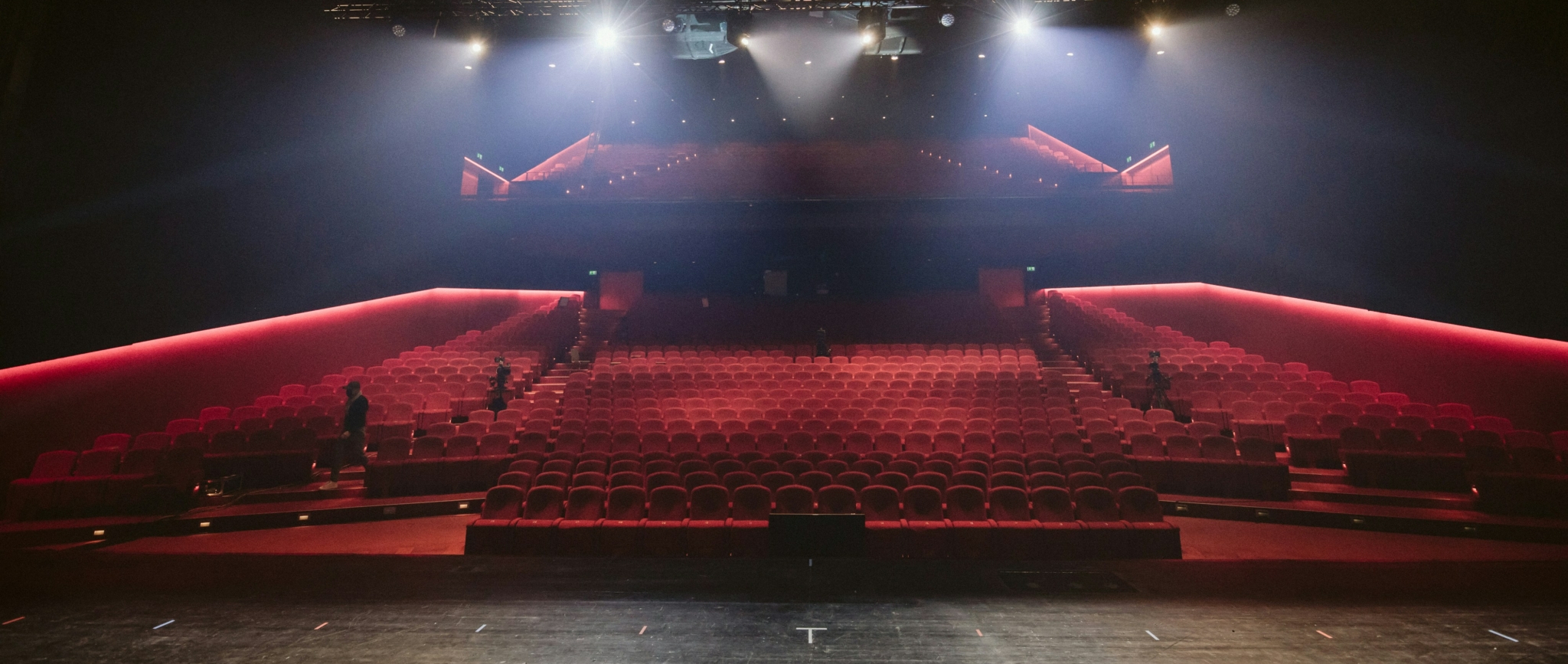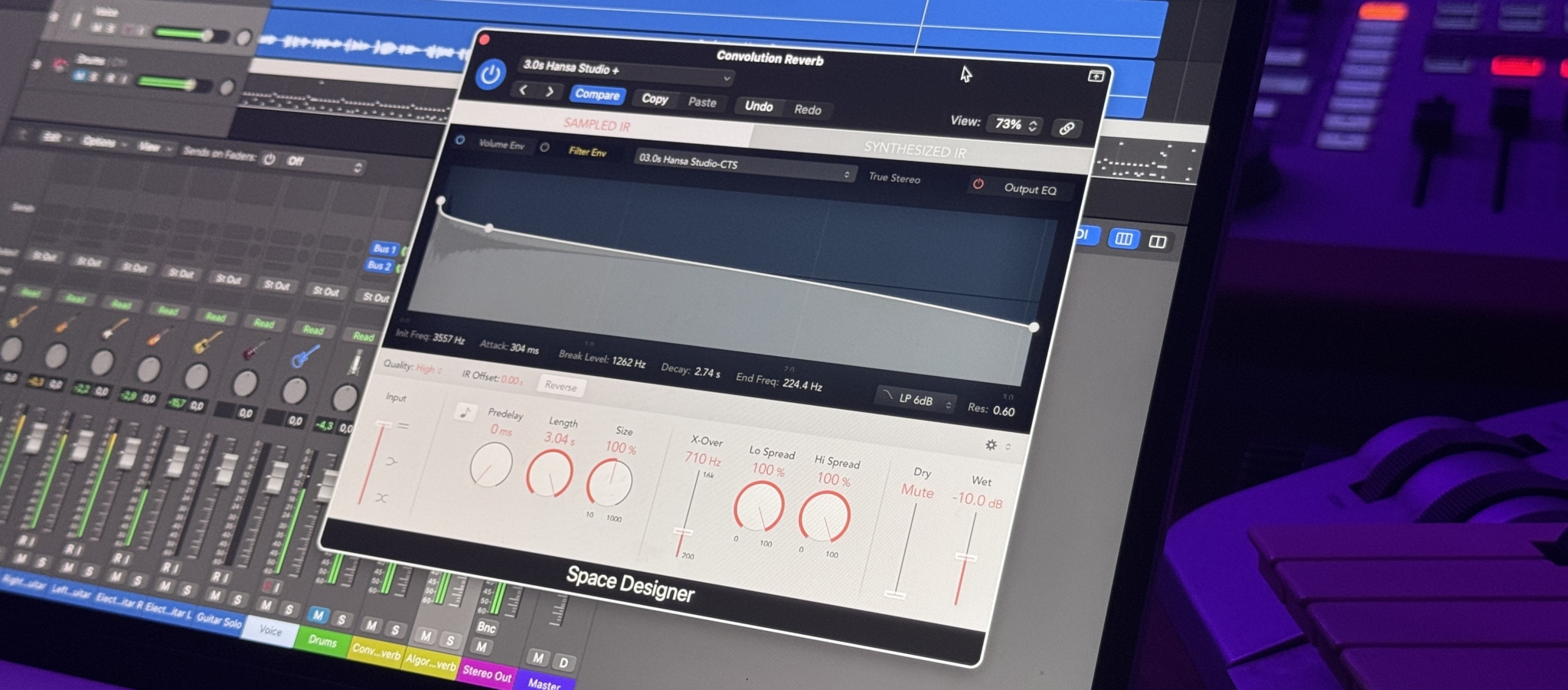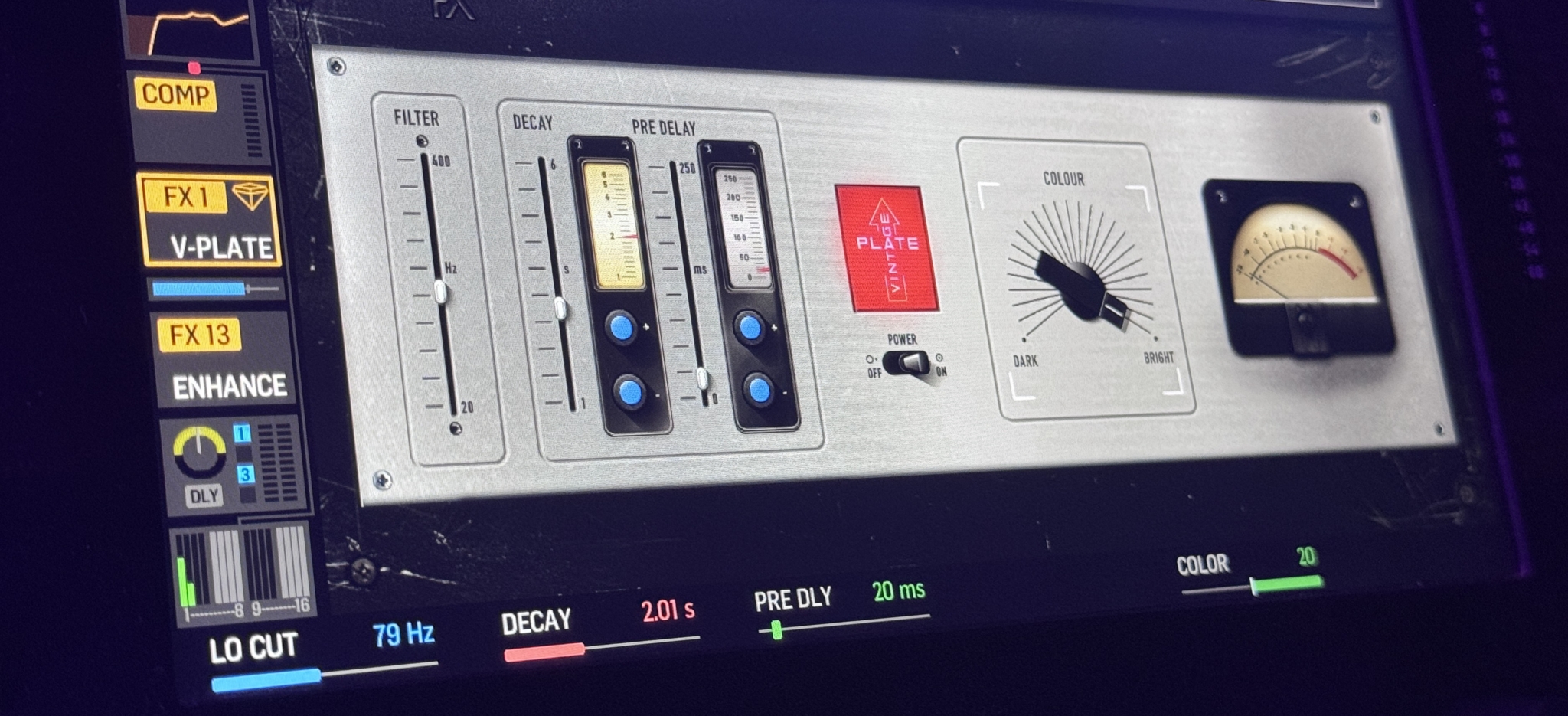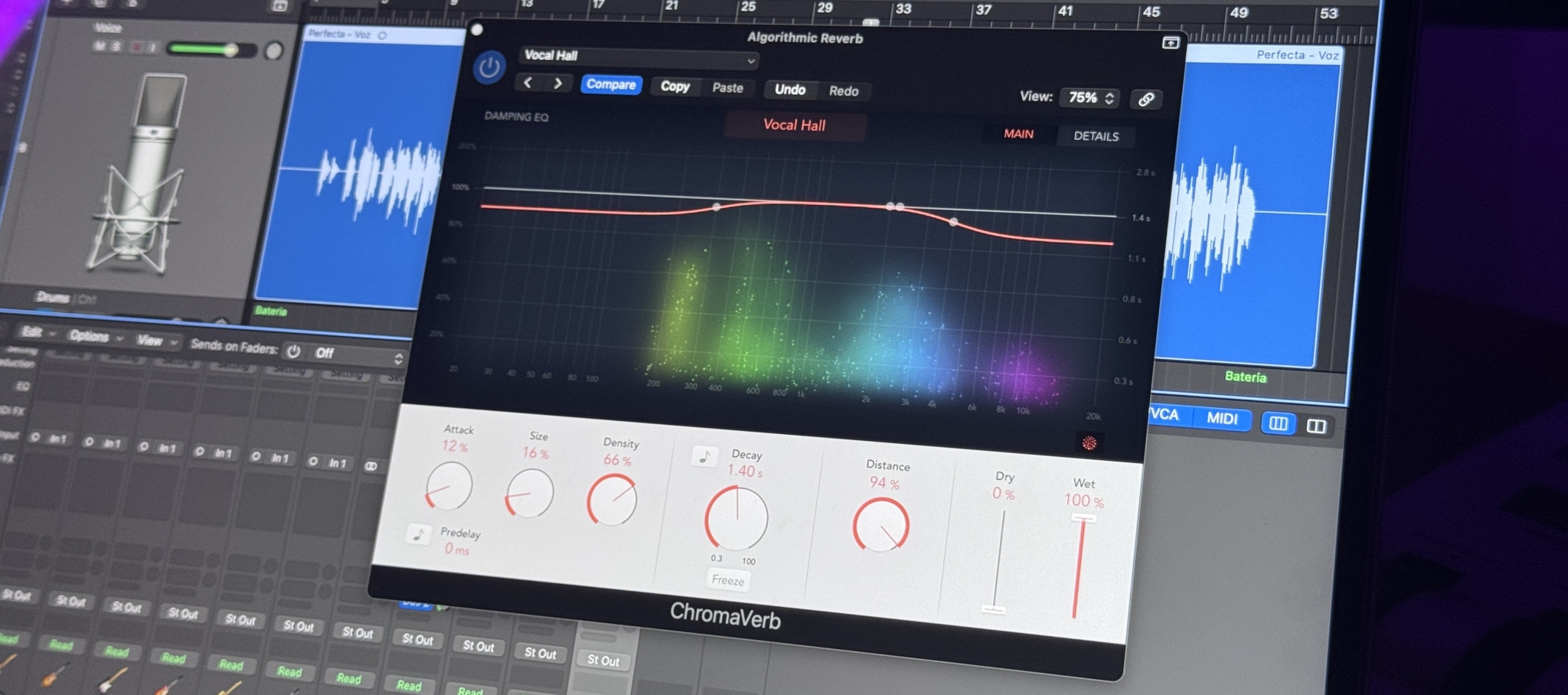Reverb is one of the most enchanting effects in audio production. It gives recordings a sense of space, depth, and emotional resonance. In this article we’ll discuss the differences between Convolution Reverb and Algorithmic Reverb so you know which one to choose in each scenario. Whether you’re mixing a piano ballad, designing cinematic soundscapes, or producing an energetic rock track, the right reverb can make all the difference in how your music or dialogue connects with listeners.
Table of Contents
- What is Reverb?
- Pros and Cons of Convolution & Algorithmic Reverbs
- Technical Breakdown
- Choosing the Right Reverb
- Examples and Use Cases of Each Reverb
- Conclusion
What is Reverb?
At its core, reverb is the collection of reflections that occur when sound waves bounce around in an environment. In the digital realm, we often rely on two primary methods to generate that sense of ambience: convolution reverb and algorithmic reverb. Each method offers distinct advantages, and understanding them can help you select the perfect approach for any creative scenario.

What’s the Main Difference Between Convolution and Algorithmic Reverb?
Convolution reverb takes a snapshot of a real acoustic environment. It does this through impulse responses (IRs)—recordings of how a short, broadband signal decays in a particular space. Convolution reverb then applies that unique “fingerprint” of reflections and tonal coloration to any audio source. By contrast, algorithmic reverb uses a set of mathematical and psychoacoustic tricks—delay networks, feedback loops, modulation, filtering—to simulate or invent a space. This algorithmic approach often affords more creative freedom and lighter CPU usage.
Why does this matter? Because choosing the right reverb technique shapes how your production sounds and feels. If you want a track to sound like it was actually recorded in a famous concert hall, convolution reverb can get eerily close to the real thing. If you need a surreal, ever-evolving reverb tail that shimmers and morphs, an algorithmic reverb might be your go-to. Many producers use both, sometimes within the same mix. In this article, we’ll explore the differences in detail, look at the pros and cons, and highlight practical use cases. By the end, you’ll know exactly when to turn to convolution for its realism and when to dial up an algorithmic reverb for its flexibility.
Pros and Cons of Convolution & Algorithmic Reverbs
In this section, we’ll break down how convolution and algorithmic reverbs stack up against each other. We’ll look at their key strengths and where each can fall short.
Convolution Reverb
Let’s start by examining how convolution reverb uses real-world acoustic data to create stunningly authentic spaces, and what trade-offs that realism might entail.

Pros: Unparalleled Realism & Authentic Character
- Unparalleled Realism: Convolution reverb uses impulse responses captured from real spaces or devices. When you load an IR of a grand cathedral or iconic studio chamber, you’re hearing that exact acoustic fingerprint. The resulting realism is often unmatched, making convolution reverb ideal for classical recordings, film scoring, and any situation where a lifelike environment is essential.
- Authentic Character: Different rooms have distinct tonal imprints. A large concert hall may emphasize certain midrange frequencies while rolling off highs over time. An underground bunker might produce a darker, more ominous decay. Convolution reverb preserves these unique acoustic nuances, allowing you to “place” sounds in specific, evocative environments.
Cons: High CPU Usage & Limited Flexibility
- High CPU Usage: Convolution involves complex math to multiply your audio by the impulse response. Longer IRs and higher sample rates require more processing power. If you’re layering multiple convolution reverbs across numerous tracks, your CPU might struggle. Some users circumvent this by placing just one convolution reverb on an aux bus, then sending multiple instruments to it.
- Limited Flexibility: Because impulse responses are essentially fixed snapshots, extreme changes in decay time or room size can sound unnatural. You can usually adjust pre-delay, EQ, or overall decay trimming, but truly reshaping the space is trickier. If you need a radically different reverb tail, you might have to swap IRs or rely on specialized stretching techniques.
Algorithmic Reverb
Now, let’s explore the algorithmic approach—where reverb is built from scratch by carefully designed delay networks and filters, offering flexibility and lower CPU usage.

Pros: Creative Control & Lower CPU Demand
- Creative Control: Algorithmic reverb is engineered from scratch. Designers assemble delay networks, feedback paths, and filters into a system that simulates reflections. In many plugins, you can tweak decay time, room size, diffusion, and modulation to shape the reverb in imaginative ways. Want a 30-second tail that evolves and shimmers? You can dial that in with a few slider movements.
- Lower CPU Demand: Algorithmic reverbs generally require fewer resources. You can often run multiple instances without overwhelming your system. If you have a dense session with many tracks, algorithmic reverb can be a lifesaver.
Cons: Can Sound Artificial & Not a Perfect Acoustic Match
- Can Sound Artificial: Older or poorly designed algorithms might exhibit ringing or metallic resonances. While modern algorithmic reverbs have improved significantly, achieving a smooth, natural decay still hinges on solid engineering. If you’re aiming for absolute realism, algorithmic approaches sometimes fall short—though high-end plugins can blur that line.
- Not a Perfect Acoustic Match: If you want to replicate a specific real-world venue, algorithmic reverb won’t capture it perfectly. It can approximate many environments, but for a truly faithful reproduction of a famous church or recording studio, convolution is generally superior.
Technical Breakdown
Here, we’ll dig deeper into how convolution and algorithmic reverbs actually function, and why their technical underpinnings matter for your mix.
How Convolution Reverb Works
This section reveals the heart of convolution reverb: Impulse responses (IR), and how they imprint the genuine acoustic characteristics of real spaces onto your tracks.
Convolution reverb revolves around the concept of impulse responses. An IR is made by recording how a short, full-spectrum signal—like a sine sweep or starter pistol—decays in a space. The resulting audio file encapsulates the reflections, frequency response, and reverb characteristics of that environment.

When you feed a dry signal into a convolution reverb plugin, the plugin performs a mathematical operation (convolution) that merges the input audio with the IR. In practice, it’s like your signal is “played” in that recorded environment. All the timings and frequency-dependent reflections of the original room get imposed on your track. This method delivers a striking level of realism since you’re using actual acoustic data.
Still, convolution can be demanding. Behind the scenes, the plugin might break the IR into small segments and use efficient algorithms to process them in real time. The longer the IR and the higher your sample rate, the more CPU overhead you incur. Some convolution reverbs allow you to shorten IRs or reduce fidelity to save on processing. Nonetheless, the more detail you preserve, the richer (and more CPU-intensive) the effect can be.
How Algorithmic Reverb Works
Now we’ll look at how algorithmic reverbs build rooms (or unearthly spaces) purely through delay networks, feedback, and modulation, without relying on sampled spaces.
Algorithmic reverbs model reverb by creating dense fields of echoes that mimic or reinvent the behavior of real rooms. Early designs used combinations of comb filters and all-pass filters to build up reflections. More modern approaches might rely on feedback delay networks (FDNs), where multiple delays feed back into each other in a carefully tuned matrix.
Developers often incorporate modulation into their algorithms. Tiny variations in delay times or phase relationships prevent static resonances and produce a lively, evolving reverb tail. High-quality algorithmic reverbs also feature frequency-dependent decay, where low and high frequencies fade at different rates, much like real spaces.

Because algorithmic reverbs are synthesized, you can tweak nearly every aspect of the reverb’s character. You’re not confined to an existing acoustic imprint. Need a huge hall that softly modulates over 15 seconds? Or a small, bright chamber with a quick decay? An algorithmic engine can do both with minimal strain on your CPU. However, the purely synthetic nature means that if realism is your top priority, you’ll usually need a carefully designed algorithm or you risk an artificial sheen.
CPU and Latency
Let’s talk about performance. These factors can significantly influence which reverb you choose in large projects or live settings.
When deciding between convolution and algorithmic reverb, CPU usage and latency can be decisive factors:
- Convolution Reverb: Tends to be heavier on CPU, especially with long or detailed IRs. Latency might arise if the plugin uses partitioned convolution with certain buffering modes, but many plugins now offer near-zero-latency processing at the cost of extra CPU cycles.
- Algorithmic Reverb: Generally lighter on CPU, allowing many instances without hitting performance limits. Latency is often minimal or zero, making it a great choice if you’re tracking live instruments and need immediate feedback from your effects.
For large sessions with many reverb-hungry elements—like in modern pop or electronic productions—algorithmic reverb can keep your workflow smoother. For projects needing meticulous acoustic authenticity, convolution reverb is worth the additional load, though you might decide to use just one or two instances on aux channels instead of many scattered across individual tracks.
Choosing the Right Reverb
Next, let’s outline some quick criteria to help you decide whether convolution or algorithmic reverb suits your current project best.
When to Use Convolution Reverb
This portion offers straightforward guidelines for opting into the unparalleled realism of impulse responses.
- Realistic Spaces: If you’re mixing a small jazz combo and you want them to sound like they’re performing in a famous club, convolution reverb delivers that authentic vibe. It’s also excellent for orchestral or chamber recordings, where the natural resonance of a concert hall adds grandeur.
- Film and Dialogue: For film, TV, or game audio where matching the on-screen environment is essential, convolution reverb is a fast and straightforward solution. You can dial up a church, tunnel, or living room IR, giving your sounds the appropriate reverberant fingerprint.
- Hardware Emulations: Some convolution plugins let you load impulse responses of vintage gear, like classic plates or spring reverb units. If you want the distinct coloration of a legendary hardware unit, convolution can come surprisingly close to the real hardware’s character.
When to Use Algorithmic Reverb
In these scenarios, the flexibility and efficiency of algorithmic reverb might serve you better than the hyper-realism of IRs.
- Creative Sound Design: Algorithmic reverbs let you push boundaries. From otherworldly shimmer tails to pitch-shifted reflections, you can craft unique ambiences well beyond any natural space.
- Efficiency: If your session is massive and you need multiple reverbs running smoothly, algorithmic reverb is generally more CPU-friendly. You can fine-tune decay, diffusion, and tonal shaping without adding significant load.
- Pop, Rock, and Electronic Mixing: Modern vocal mixes often rely on algorithmic reverbs for that signature sheen. Drums in rock or electronic tracks might need bright, snappy rooms or huge, modulated halls. Algorithmic reverbs are built for this kind of everyday mix shaping.

Balancing Both Approaches
This section highlights the synergy you can achieve by combining convolution’s realism with algorithmic reverb’s versatility in a single project.
No rule says you must limit yourself to only one type. In fact, some of the most compelling mixes layer convolution and algorithmic reverbs:
- Convolution for the cohesive, natural ambience.
- Algorithmic for sculpted tails or special effects.
By combining them, you retain a grounded sense of space while exploring surreal or artistic reverb trails where desired. You can also mitigate CPU strain by using a single convolution instance on a shared aux, then sprinkling algorithmic instances on select elements that need distinct treatments.
Examples and Use Cases of Each Reverb
In this section, we’ll explore real-world scenarios where convolution or algorithmic reverb might take center stage. From orchestral recordings to electronic soundscapes, each approach can yield unique results.
Acoustic and Classical Recordings
Here’s how convolution reverb excels when realism and natural ambience are key to matching the music’s acoustic qualities.
Imagine you’ve recorded a string quartet in a dry studio space. You want the final mix to sound like it was captured in a lush, world-class concert hall. Convolution reverb is perfect here. By loading an impulse response from a renowned venue, you can imbue your strings with that hall’s signature reflections, creating an authentic, immersive experience. The natural decay and subtle coloration make the quartet feel organically placed in a grand environment.
For solo classical instruments like piano or violin, convolution reverb can add a sense of realism and emotional warmth. Instead of sounding isolated in a dead space, the instrument now breathes in a believable acoustic context. If you’re mixing film music that needs to blend with the ambience of a scene, convolution reverb can also help you match the background environment accurately.
Vocal Mixing in Pop/Rock
We’ll see how algorithmic reverb’s flexibility often gives pop and rock vocals that signature glossy tail or short ambiance.

A lead vocal in a pop or rock song often benefits from algorithmic reverb. You might want a plate-style reverb that’s bright, smooth, and doesn’t muddy the mix. Algorithmic plates can produce that iconic sheen, with adjustable decay and a musical tail that complements the singer’s tone. If you want a short, tight ambience for an intimate ballad, an algorithmic room preset can deliver that quickly—no rummaging through multiple IRs to find the perfect small room sound.
Another advantage of algorithmic reverbs on vocals is the ability to modulate or shape the tail. You can easily tame certain frequencies or add shimmer for a modern, ethereal effect. If your CPU budget is tight, algorithmic reverbs also let you put distinct reverb instances on backing vocals, guitars, or synth pads without overloading your system.
Electronic Soundscapes
Dive into how algorithmic reverbs shine when crafting otherworldly tails or evolving ambiences in electronic and ambient music.
Electronic and ambient music often leans heavily on creative reverb tails. Producers love to push reverb times far beyond normal boundaries, turning short notes into evolving pads or cascading washes. An algorithmic reverb plugin that offers extensive parameter control becomes a playground of sonic possibilities. You can add modulation, freeze functions, or pitch-shifting to craft completely unreal environments that suit futuristic or experimental tracks.
While you could load a giant cathedral IR in a convolution reverb, you may be stuck with that space’s inherent tonality. Algorithmic reverb lets you craft a space that doesn’t exist in reality. If you need an impossibly large cosmic swirl, it’s only a couple of clicks away. For some genres—like ambient drone, IDM, or cinematic sci-fi—algorithmic reverb is indispensable for producing dreamy, otherworldly textures.
Film, TV, and Game Audio
Here, we’ll see why convolution reverb is invaluable for placing sounds in believable scenes, while algorithmic reverb helps with dynamic transitions.
In film or game sound design, it’s crucial to match dialogue and effects to their on-screen locations. Convolution reverb offers a quick solution if you have an IR of a similar environment—like a narrow corridor, warehouse, or cave. It immediately grounds the audio in that space, making it sound natural and cohesive with the visuals. Foley artists often rely on convolution reverb to place footsteps or object interactions convincingly.

However, algorithmic reverb also plays a big role in post-production. If you need a reverb that dynamically changes as characters move from one environment to another, an algorithmic approach can offer smoother transitions. Some engines even let you automate parameters in real time, simulating changes in room size or reflective surfaces as the scene evolves.
Hybrid Techniques
Sometimes, mixing convolution and algorithmic approaches yields the best of both worlds. Let’s see how layering reverbs can boost realism and creativity.
Many producers blend both reverb types. For instance, you can run a convolution reverb on a bus with a carefully chosen impulse response, giving the entire mix a subtle sense of cohesive space. Then, for lead instruments or vocals that need an extra push or a unique flavor, you add an algorithmic reverb. That might be a bright plate, a long hall, or a modulated special effect.
You could also use convolution for early reflections—capturing the immediate sonic cues of a room that provide localization—then transition into an algorithmic tail. Some modern reverb plugins incorporate both methods under one hood. This approach can reduce CPU usage while preserving a natural spatial impression. It’s a clever way to get the best of both worlds without juggling multiple plugins.
A Practical Example
Here’s a concrete illustration: how a single track might integrate convolution for foundational realism and algorithmic reverb for artistic flourishes.
Suppose you have a track featuring acoustic guitar and a vocal duet. You want a realistic sense of space overall, so you load a convolution reverb with a cozy studio IR on an aux channel. Both guitar and vocal tracks send to this aux, helping them feel unified.
But in the bridge, you want the vocals to soar into a more ethereal realm. You insert an algorithmic reverb with a longer decay on just the vocal bus. You dial in a subtle shimmer so it blossoms in a way that no real studio space would. The track now transitions from realism to a more expansive, imaginative moment—perfect for building emotional impact.

Conclusion
Finally, let’s wrap up our deep dive by reflecting on how both reverb types can transform your creative workflow and elevate your mixes.
Convolution and algorithmic reverbs may both produce reverb tails, but they come from fundamentally different philosophies. Convolution reverb is all about realism, capturing the unique acoustic personality of a specific place and imposing it on your audio. Algorithmic reverb, on the other hand, thrives on flexibility, letting you design or morph spaces to fit any sonic vision.
If you’re mixing a classical ensemble, trying to authentically replicate a concert hall, or adding depth to a film scene, convolution reverb can be indispensable. It provides an uncanny sense of “being there,” complete with every subtle reflection and coloration. For creative sound design, pop vocals, and massive electronic builds, algorithmic reverb offers the freedom to craft tailor-made reverbs—low CPU hit, infinite decay, strange modulations, and more.
Ultimately, these two approaches aren’t competing so much as they are complementary. Many projects incorporate both. A single track might rely on convolution for an overall realistic space, then dial in an algorithmic plugin for dramatic flourishes during certain sections. This balance of authenticity and creativity can inject life, dimension, and intrigue into your productions.
As you explore different plugins, you’ll find some convolution reverbs that load IRs from famous studios, cathedrals, and hardware units, and some algorithmic reverbs with advanced modulation or shimmer features that can transform your audio into something completely new. Learning how to wield both is a key step in mastering modern mixing and sound design.
Let your ears guide you. If a convolution reverb on a vocal conjures exactly the mood you want, go for it. If an algorithmic plate or hall opens up the mix in a magical way, ride that wave. The studio is your playground, and reverb is one of your most powerful tools for shaping a listener’s perception of space. Don’t hesitate to experiment—some of the most memorable mixes and scores come from pushing these technologies to their creative limits.
About the Author

Dídac
CEO & Founder of MasteringBOXDídac is a professional audio engineer, music producer and software engineer. He is the founder of MasteringBOX and the author of many of the articles on the blog.
Leave a comment
Log in to comment


